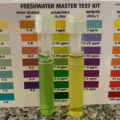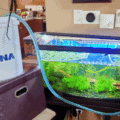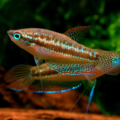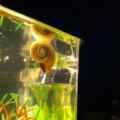Navigating the delicate situation of a dying pet fish requires both knowledge and compassion, and in this comprehensive guide, we explore exactly what to do when faced with this challenging reality. This article provides invaluable insights into recognizing the common signs of a fish in distress, from changes in behavior to physical symptoms. Learn how to assess water quality parameters and perform necessary maintenance to address potential stressors in your aquarium environment.

If you have a fish that is dying, you need to check every water quality parameter. Observe your fish for any obvious signs of stress. You should also make sure that basic maintenance has been done, including filter media cleaning. Sometimes fish simply die of old age and not due to negligence on your part.
Or a disease may truly be terminal.
That’s why we’ll also discuss ways of easing any pain that your fish may be feeling.
Common Signs of a Dying Fish That Needs Help
A dying fish is something all aquarists inevitably have to deal with.
So how can we tell when a fish is dying?
- Floating near the surface: a floating fish is not a healthy fish. Fish may pause to survey the area or look for food. But floating at the surface for a long time is a sign of weakness. The fish’s fins are often held against its body. Fish owners should be looking for a cause immediately. If the floating fish is also turned upside down or sideways, and displays difficulties swimming straight then you’re likely dealing with swim bladder disorder. Fish that swim upside down like that can also appear bloated in the belly area.
- No response to fresh food: adding fish food should get the attention of your entire aquarium. A few fish may not decide to eat. But if they also show additional signs of imminent death, I’d be concerned. Skipping multiple meals is also a sign to look into. When a fish goes without eating for a long time, its belly will curve in towards the spine. Over longer periods most fish will also lose muscle mass and their eyes will start to sink into their head.
- Faded colors: bright colors are just one of the ways that tropical fish signal to one another. But as a fish dies it loses interest in communicating with other fish species. It puts what little energy it has into breathing and staying afloat or hidden. A bright blue betta fish often turns a paler shade as stress symptoms become worse.
- Constantly hiding: as a fish’s death approaches it may hide instead of float. Hiding is a major symptom, especially in schooling or social fish like tetras and cichlids. Hiding is also a common way of losing fish after they die. You should be vigilant to remove any dead animals from your aquarium as soon as possible. Warm water quickly breeds bacteria. These germs break down the fish, releasing ammonia in the process. This ammonia spike can cause even more fish to become weak and die if you don’t locate the dead fish.
- Excessive sleeping: when the lights come on aquarium fish are usually quick to wake up fully. They darken their colors and become more active. But a fish that seems to sleep for hours past first light is acting strange. Fish sleep can be tricky to understand. After all, fish don’t have eyelids to show when they are sleeping, like mammals do. If you’re a Betta owner, the topic of betta fish sleep is covered extensively right here!
- Lying on the bottom for no reason: This symptom obviously excludes bottom-dwelling fish like corydoras, pleco fish and other catfish. But if your pet fish is spending more time sitting at the bottom of its tank than normally, its behavior can be a sign that the animal has low energy levels. The energy level of a fish is the result of its metabolism. A slowed down metabolism in fish can be caused by bad oxygen intake from the gills or their immune system fighting off a disease. The former can be the result of a badly oxigenated aquarium water or ammonia poisoning which harms the ability of gills to absorb oxygen.
There are many more common signs of a dying fish that go beyond the scope of this article. Fortunately, this topic is covered in even greater depth here.
This video is also an excellent visual guide to identifying when a fish is dying:
What to Do When Your Fish is Perishing to Save it?
For the best treatment results, I recommend consulting with a veterinarian about your sick pet fish. However, sometimes that’s not an option.
A fish that is close to death may still be saved.
Here are some quick corrective actions you can take.
Check the Water Quality in the Fish Tank
The first thing you should do whenever a problem arises is to check the water quality.
Many fish deaths and even diseases are caused by shifts in water parameters.
Even if your water looks clean, there may have been a spike in ammonia. A dead snail, excess food, or too many fish can cause levels to rise.
In a mature aquarium, its beneficial bacteria will take care of any excess ammonia.
But sometimes the levels rise faster than they can process.
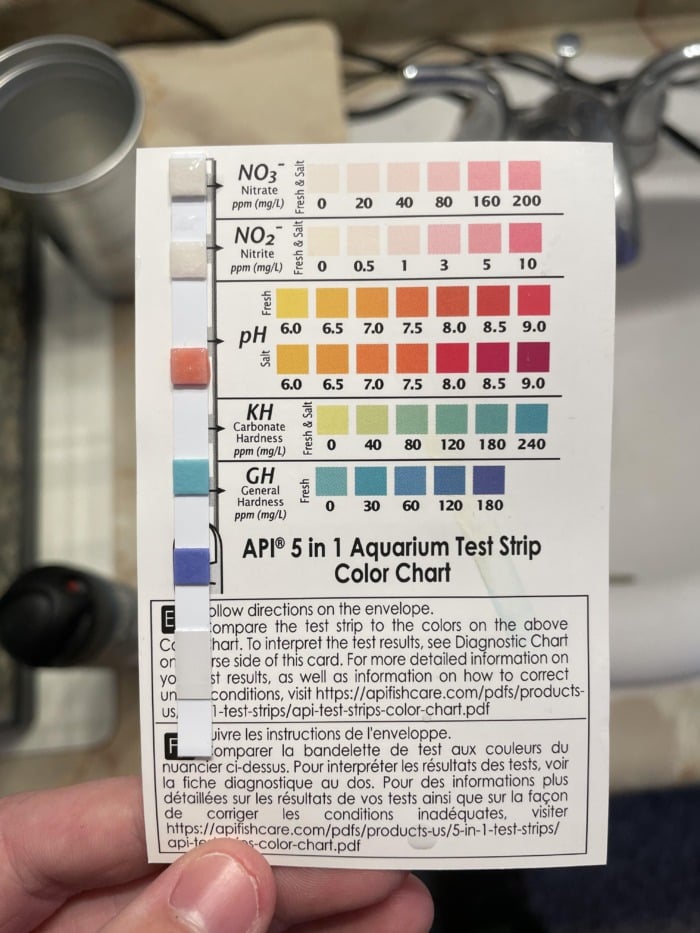
I always have a freshwater master test kit on hand for regular water testing. A liquid test kit takes longer to get results than the testing strips.
But it is much more accurate and is worth the fuss.
Start with testing for ammonia, nitrite, and nitrate.
Elevated waste levels are a common way for a fish’s life to end.
If these parameters are in the safe zone, check your pH as well.
If there has been a large shift since the last time you checked it, it may help you figure out what is causing your fish stress.
PH swings can be caused by many changes. Including adding tannin-rich driftwood pieces, changing the substrate with some sort of aquasoil, or doing large water changes.
Perform a Water Change
Water changes are always a good idea when you have a sick fish.
Your test kit may not have the right test for a given pollutant.
Water changes also improve water quality by removing fish waste, which decays and can cause a bacterial infection.
By adding fresh water to the aquarium you are giving your sick fish a better chance.

Plus, the other pet fish in the tank are less likely to succumb to any water quality issues.
A 30% tank water change is recommended as a preventative measure.
Any higher and you risk shocking your fish further through a sudden shift in water parameters.
Even if it would remove more waste.
Watch for any signs of stress after even a small water change. Rapid breathing, shimmying, seizures, and scratching against decorations, for example.
These indicate that something in the water is irritating them, such as untreated chlorine.
Raise the Water Temperature
Fish die when the water temperature falls below their preferred range.
But by raising the water temperature you can boost their metabolism, activity, and appetite.
Don’t forget to give frequent meals to fish kept in warm conditions.
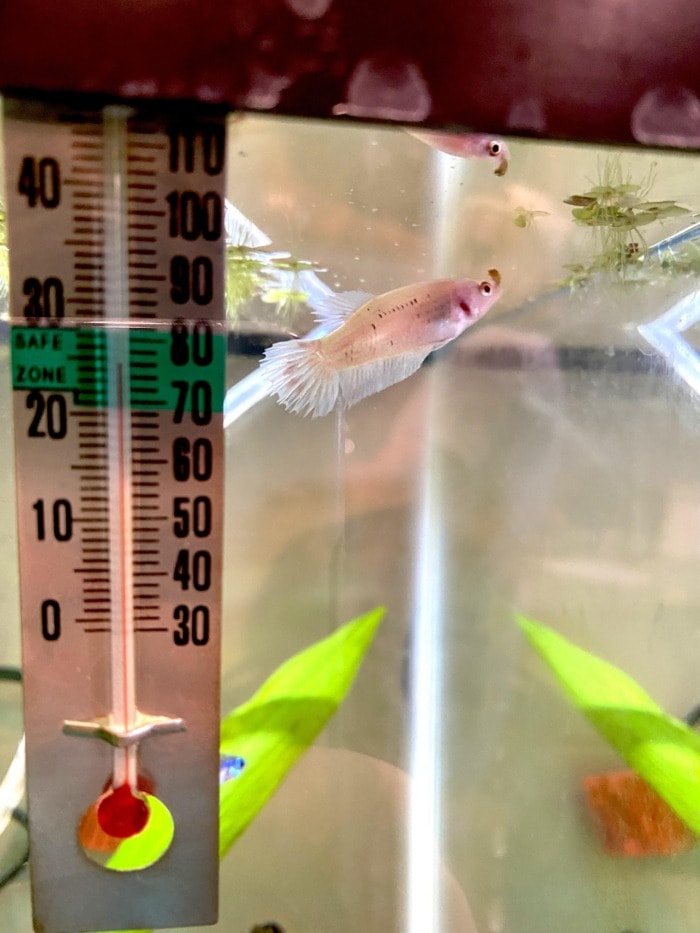
Since they are moving more, they should also be fed more often.
The ideal temperature depends on the species of fish you have.
I also recommend adding aeration when raising water temperatures.
Warm water has lower oxygen levels than cold water.
Gentle splashing from a power filtration system helps. But an airstone and air pump boost the dissolved oxygen content even more effectively.


Dying fish often have trouble breathing.
The less work they have to do to survive, the greater their chances of recovery are.
Add Aquarium Salt
An aquarium salt bath is a great general tonic for dying fish when you aren’t sure of the precise cause.
Salt stimulates the production of body slime, blocking parasites and helping wounds to heal. Moreover, salt helps freshwater fish deal with Nitrite poisoning.
It also improves ion exchange across gill membranes, helping fish respire and release ammonia more efficiently.
A salt bath will even kill many external parasites like flukes and worms outright!

But not all salt is created equally.
Table salt must not be used; it has iodine, anti-caking agents, and other additives. Instead we want natural sea salt, aquarium salt, or pure Morton’s rock salt.
Natural sea salt is additive-free.
Four ounces of salt per gallon of water is a good therapeutic dose.
You need to use aquarium water for mixing your salt bath, not tap water.
- Mix the salt into the water thoroughly before adding any fish.
- Next, net the sick fish and add it to the bath container.
- Let it soak there for 3 to 5 minutes.
The fish may thrash a little as the salt will sting.
However, it won’t die during such a short bath.
After the bath is over, remove the fish back to your bigger tank.
With luck, the salt will stimulate the healing process.
Remember that many fish are too sensitive to salt for it to be used as a tonic.
Especially species that thrive in soft and acidic water or species that lack scales.
Cardinal tetras, clown loaches, and corydoras can be killed by even low levels of salt.
Set Up a Quarantine Tank
Removing a dying fish from your main aquarium has many advantages.
For one, if the fish is sick you lower the chances of it spreading the disease to its tank mates.
Besides this, the treatment of all kinds of illnesses becomes easier in a separate smaller container.
The caveat of removing a sick fish from your display fish tank is that you’ll need to set up a temporary hospital or quarantine tank which requires time and resources.
I always recommend having a quarantine or hospital tank ready for isolating and treating sick fish at home if possible.
You can have it running continually.
Or have a small fish tank that is quick and easy to set up, like a 5 or 10-gallon aquarium!
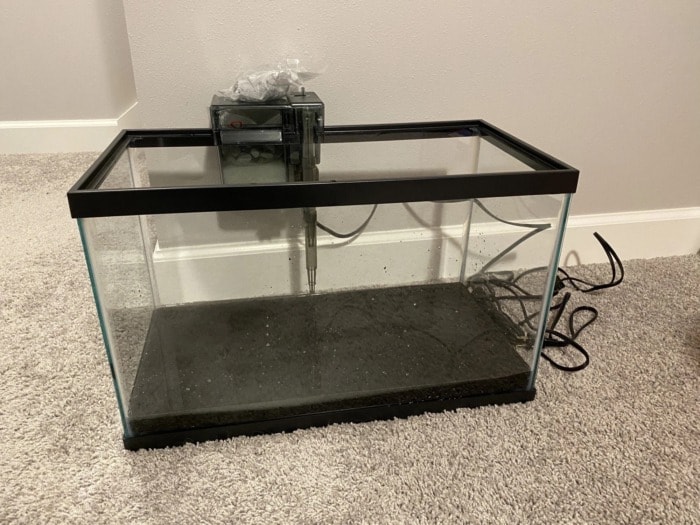
A quarantine tank separate from your community tank means that you don’t need as much medication to treat a dying fish. Medications and aquarium salt are good for many – but not all fish.
Loaches, catfish, and tetras are highly sensitive to both salt and medications.
A sick fish also does not have to compete for fish food in a quarantine tank. Small feedings keep waste levels low.
Hospital tanks are also handy when buying new fish from your local pet store. Retail tanks are often full of ich and other contagious diseases.
Keeping fish quarantined for a few days helps keep your main tank free of sickness!
Can You Save a Pet Fish From Dying of Old Age?
A fish that has led a long and happy life will eventually have to contend with death.
This is a success on your part as a fish keeper.
This is proof that your beloved pet was well cared for.
It’s time to enjoy what time together you have left and, perhaps, comfort it.
Signs of old age can be hard to detect in aquarium fish.

Some fish don’t change much once they reach adulthood while others do.
Male African cichlids and many other fish often grow large nuchal humps as they age.
Long, pointed fins, frayed fins, cloudy eyes, and old scars are common signs of age in fish.
An older fish will swim slower and may take more time to wake up in the morning.
The symptoms of old age in fish unfortunately overlap with the general symptoms of sickness.
A fish that’s nearing its end days will be more lethargic, less interested in food, and be more pale in color.
This makes it extremely difficult do diagnose old age if you don’t know the average lifespan of your pet fish.
Do you know how long is your fish supposed to live on average? 1 to 3 years is normal for small freshwater fish and shrimp.
Betta fish live for 3 to 5 years. Some reef fish can live up to 41 years!
There is a lot of variation in lifespan.
But generally speaking, smaller fish live short lives and larger fish live longer.
Can a Dead Fish Be Revived?
If your fish has died just recently, there is nothing you can do.
A dead fish is just like any other dead animal and it’s not coming back.
The only way a fish gets “revived” is if it wasn’t really dead.
Has your fish really stopped breathing or is it just breathing very shallowly?
Wait to see if its colors fade before giving up on it.
A slowly dying fish may look bright still. But within a few hours, its colors will fade if it is truly dead.
Euthanizing a Dying Fish
Some diseases can reach a terminal phase.
If your fish has terminal dropsy, cancer, pop-eye, swim bladder disease, and other seemingly impossible-to-treat disorders, then it may be time to ease its passing.
In general, if your fish displays any symptoms of sickness it is more or less suffering.
For this reason, for some people it makes sense to euthanize a fish that has an incurable disease going on.
There are ways to eithanize your pet fish humanely but euthanization should be your absolute last resort after making sure there’s nothing else you can do to save the animal.
Using Clove Oil
The best way to end the suffering of a dying fish is to use clove oil.
Clove is a natural antiseptic and popular aromatherapy oil.
When added to water in small amounts it acts as an anesthetic for fish.
But larger amounts of clove oil will shut down breathing entirely.
A dose for putting fish under anesthesia is 5 drops per gallon of water.
If we want to give our fish a peaceful death, we need quite a bit more.
First, you will need to catch your dying fish.
Place it in a small container of water.

Next, take a quarter cup of water and add it to a plastic bag or other shakeable container.
Add 10 drops of pure clove oil.
Then, shake it up vigorously so the oil and water temporarily mix.
Add 1/2 of the clove oil and water mixture to the container with your fish.
Its breathing will slow over the course of 10 minutes, eventually stopping.
After 10 minutes, add the rest of the water+oil blend.
Do not remove the fish from the mixture for an hour.
This much clove oil is always fatal to them but we want to be certain.
Freezing Dead Fish
The second best method for ending the suffering of a dying pet fish is to freeze it.
As the water’s temperature falls in the freezer, its metabolism will slow and slow.
The fish does not feel pain in the cold water.
It simply falls asleep and eventually dies, well before the water freezes solid.
A small cup of water is all you need; a larger amount of water will slow down the cooling process.
Drawing out its death, which we don’t want to do.
Conclusion
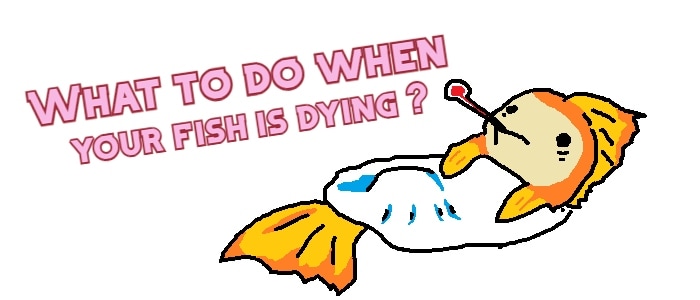
Keeping our fish happy will go a long way towards avoiding unnecessary deaths.
But sometimes disease, water quality shifts, or old age mean that we have to consider the possibility of dead fish.
That said, the information in this guide will give you the power to prevent most early deaths!





